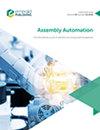A modified cut-set method for mechanical subassembly identification
IF 1.7
4区 计算机科学
Q3 AUTOMATION & CONTROL SYSTEMS
引用次数: 11
Abstract
Purpose The purpose of this paper is to perform a comparative assessment on working of the existed subassembly identification (SI) methods, which are widely practiced during the product development stage and to propose an improved method for solving the SI problem in assembly sequence planning (ASP). Design/methodology/approach The cut-set method is found as a suitable method among various knowledge-based methods such as the theory of loops, theory of connectors and theory of clusters for the workability enhancement to meet the current requirements. Necessary product information is represented in the matrix format by replacing the traditional AND/OR graphs and the advanced predicates are included in the evaluation criteria. Findings The prominent methods in SI are followed a few of the predicates to avoid complexity in solution generation. The predicate consideration is found as the most influencing factor in eliminating the infeasible part combinations at SI. However, the quality of identified subassemblies without advanced predicates is not influencing the solution generation phase but practical applicability is affecting adversely. Originality/value The capability of performing SI by the cut-set method is improved to deal with the complex assembly configurations. The improved method is tested by applying on different assembly configurations and the effectiveness is compared with other existent methods of ASP along with the conventional method.一种改进的机械部件识别切割集方法
目的对产品开发阶段广泛应用的现有子装配识别方法进行比较评价,提出一种改进的解决装配顺序规划(ASP)中子装配识别问题的方法。设计/方法/途径在环路理论、连接点理论和聚类理论等基于知识的方法中,切集方法是一种适合于提高可加工性的方法。通过替换传统的AND/OR图,以矩阵格式表示必要的产品信息,并将高级谓词包含在评估标准中。研究结果:SI中的主要方法遵循一些谓词,以避免解决方案生成的复杂性。发现谓词考虑是消除不可行零件组合的最大影响因素。然而,没有高级谓词的已识别子组件的质量不会影响解决方案生成阶段,但实际适用性会产生不利影响。独创性/价值改进了割集法执行SI的能力,以处理复杂的装配结构。将改进方法应用于不同的装配构型,并与现有的ASP方法及常规方法进行了有效性比较。
本文章由计算机程序翻译,如有差异,请以英文原文为准。
求助全文
约1分钟内获得全文
求助全文
来源期刊

Assembly Automation
工程技术-工程:制造
CiteScore
4.30
自引率
14.30%
发文量
51
审稿时长
3.3 months
期刊介绍:
Assembly Automation publishes peer reviewed research articles, technology reviews and specially commissioned case studies. Each issue includes high quality content covering all aspects of assembly technology and automation, and reflecting the most interesting and strategically important research and development activities from around the world. Because of this, readers can stay at the very forefront of industry developments.
All research articles undergo rigorous double-blind peer review, and the journal’s policy of not publishing work that has only been tested in simulation means that only the very best and most practical research articles are included. This ensures that the material that is published has real relevance and value for commercial manufacturing and research organizations.
 求助内容:
求助内容: 应助结果提醒方式:
应助结果提醒方式:


